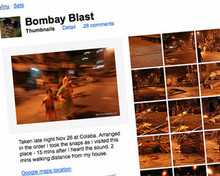
This is not the first time the world is witnessing a huge event through user-generated content, Mishra, the Yahoo! Fellow in Residence for the Institute for the Study of Diplomacy at Georgetown University, told Journalism.co.uk.
Take the Asian Tsunami coverage as an example, Mishra said. "At that time there was no Twitter but people were text messaging from the ground.
Over the last 24 hours, 'in terms of original content there's extremely little', he added.
"The only meaningful example of first hand citizen journalism in the entire episode," Mishra said, "were the 100 plus photos from Vinukumar Ranganathan, or 'Vinu', uploaded on Flickr, early in the seize.
"I would have expected at least a few others to venture out and shoot photos or videos. That's only beginning to happen as the day comes to an end," he said.
"I kept going through Flickr and YouTube all of last night, and there was nothing. Television recordings. Not a single user-generated video."
"Even in terms of blogs. A lot of Tweets about it, but very few people have tried to put together a narrative on their blogs. The only first person narrative is by Amit Varma and Sonia Faleiro - both of whom are writers and bloggers. They've written about it in a meaningful way."
It's not so much a story about user-generated citizen journalism, but one about people sharing information, such as helplines, he added.
There's a 'nice interplay' between Twitter and mainstream media, he said. "Both of them are listening to each other and there's an interesting interplay there. It's the first time this has happened in India."
Popularity of Twitter
"Lots of people are Tweeting, who would have blogged otherwise. It's a mix of many things. It's a question of access," he said.
Whereas specific types of phones, or computers are needed for updating blogs, Twitter allows quicker dissemination of information, he said.
"By Tweeting, they can tap into [an existing] momentum on Twitter and get out what they're saying much faster," Mishra said.
The mainstream media has quoted Twitter as a source, he said. "That's a big thing, for India. Many people hadn't even heard of Twitter before."
A lot of people discussed how Twitter isn't a reliable source of information, he said, adding that "of course it's not a reliable source of information!" There is a huge and diverse mix of people using Twitter to spread information, he explained.
He had deleted religious extremist comments from his own blog, he added.
Not much 'new' news
The interesting thing, he said, was that there wasn't much new information to report over the first 18 hours.
"Of course, there are some developments," he said, "but everything is still speculation."
"You can speculate about it, or you can report facts, which too many people are doing. You try to look for [other] voices."
After the event
"When all this has happened, people will write post after post on this, and analyse it," he said.
"At some point in time, I'd like to go back and make some sense of this," he said.
Mishra said his own motivation was not to report events at the scene, but to look at how it was being covered by social media: "I started tracking it to stop myself worrying about it. All my friends were in Bombay; I was in Bombay myself three months back. This was all extremely personal to me," he told Journalism.co.uk.
"I have tried not to keep linking to the media stories because a lot of other people were doing that," he said.
"Also, I'm not in Bombay. I don't see what's happening there. So, I wanted to put together a narrative of what people are talking about there from Bombay and otherwise, tracking discussions on how people are using social media."
Journalism.co.uk will update the Editors' Blog with relevant links but here is a quick summary of useful links, additional to the ones in the article:
- Roomatic collection of Twitter updates
- Mumbai Help blog
- Wikipedia current event page.
- Mahalo collection of 'Mumbai Terrorist Attack' information
Free daily newsletter
If you like our news and feature articles, you can sign up to receive our free daily (Mon-Fri) email newsletter (mobile friendly).
Related articles
- How India's The Quint covered Rishi Sunak's first week as UK PM
- Newsrewired: get your early-bird ticket today and save £30
- Try to ask the public "Are you happy?" next time you are covering an election campaign
- Event: (The lack of) diversity in independent publishing
- MoJo checklist: covering political events with a smartphone during covid-19









